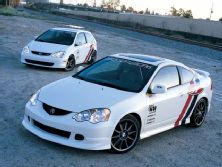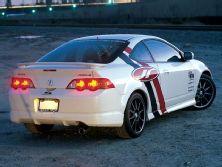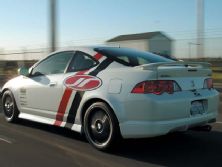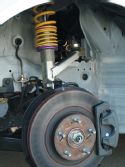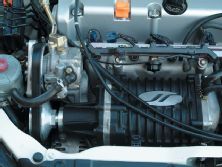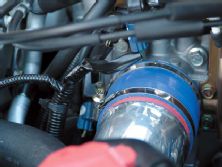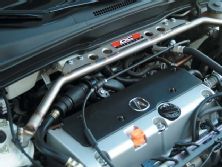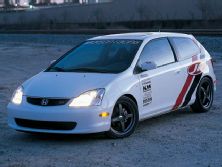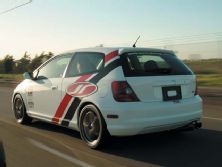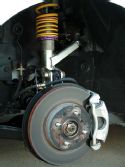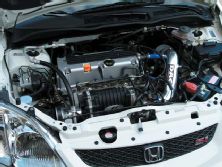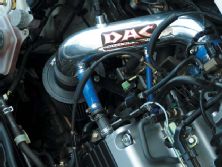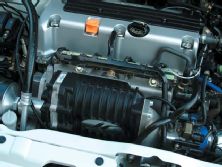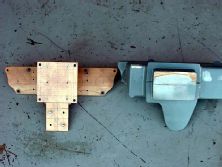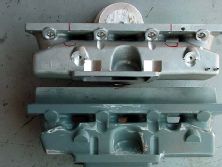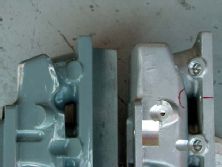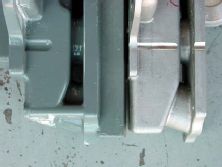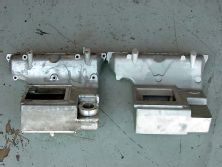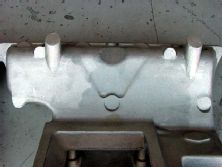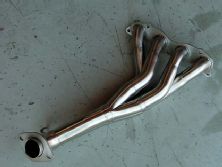It's on.
The heat on the RSX and Civic Si forced induction aftermarket is blistering in the wake of Jackson Racing's K20A2/A3 supercharger debut. Sure, you can squeeze the K engines with nitrous. A few custom turbo kits exist. But here now is a CARB low emissions-certified blower kit - with warranty - for the RSX Type-S and Civic Si.
How much horsepower does it make?
Good question. The inconsistency of K-series dyno numbers prevents an easy answer.
But here's some perspective: We dyno'ed a stock RSX-S at our tech center back in the Nov. 2002 issue. It hit 157.8 hp. On the same dyno, Sport Compact Car magazine editors pulled 172 hp from it. When it was still in stock form, Jackson Racing's RSX-S put down 159 on JR's in-house Dynojet.
Same story with the stock Si. Jackson ran it for a 126.3. SCC editors pulled 140 out of it (we ran it on a Bosch dyno and got just shy of 150 hp - DF). See the pattern?
For this reason, Jackson Racing recommends a full intake/header/exhaust upgrade, as well as ECU reprogramming, to accompany its new blowers. You could run a JR supercharger on a bone-stock RSX-S and Jackson says you'd get from 160-220 hp. For the Civic Si, figure 130-165 hp at the wheels. But running a blower on a stock powerplant is a bit like setting up a eunuch with Brooke Burke - what's the point? Kitted with DC Sports intake and cat-back exhaust, Jackson Racing header and Hondata flash-programmed ECU, the JR Type-S is putting down 258 hp at the wheels at 165 lb-ft torque. With identical mods, the Jackson Si puts down 206 hp at the wheels at 125 lb-ft torque. Pavement performance is equally impressive. We drove the first RSX-S prototype in September '02 on a hot day in Fontana, Calif. The car used a prototype manifold and an old model supercharger on stock tires, suspension and exhaust.
On that 100-degree day, the prototype pulled off a 14.7-second quarter mile. A stock RSX-S did the same trick in 16.2 seconds. When we drove the car again recently in better weather and with aftermarket intake and exhaust, it blistered the quarter in 13.8 seconds at 104 mph.
V6 Accord Inspires
Blower Development
Bringing the supercharger from the drawing board to the engine compartment is a long story. It starts, strangely enough, with V6 Accords. Jackson Racing originally set out to improve the efficiency and shrink the dimensions of its Accord blower.
"Something had to be moved in the engine compartment, either the battery or relocating something else," Jackson says. "At the time, I felt that relocating the battery was unacceptable." He decided to redesign the supercharger case instead.
The supercharger's physical size is defined in part by Eaton, the manufacturer of the rotors and gearset. Asking Eaton to design a smaller box seemed logical. But the company had different priorities.
"Eaton started making improvements to its supercharger several years ago, putting in bigger bearing plates to carry the loads better and different intake and exhaust ports," Jackson explains. "So it had better efficiency, but the physical dimensions started getting longer."
Eaton's biggest customers include automakers like Mercedes-Benz, General Motors and Jaguar. Jackson Racing is by comparison a smaller fish. Any tweaking would have to happen in-house. Rotors and bearings are a defined size, limiting how small the housing can be designed. But there is still some wiggle room and design inspiration came from Magnuson, another maker of superchargers.
Magnuson incorporated the bypass valve into the supercharger housing. The bypass valve is a fundamental component, ensuring the blower doesn't boost the engine at light throttle. This saves fuel and engine life and reduces unnecessary internal loads. Jackson Racing studied other designs, incorporated its own space-saving ideas, and emerged with a smaller case that could house the latest, most efficient rotors from Eaton.
The results, Jackson says, were excellent. "We finally did the testing on the flow bench and had tremendous increases in efficiency over all the other designs currently in use."
During this development process, Acura debuted the RSX with its K-series engine. Not only had Honda engineers shrunk the engine compartment to open up passenger space, they'd also introduced a clockwise rotating engine. As if the RSX wasn't bad enough, the Si's engine bay arrived even tighter.
It proved a hurdle for Jackson Racing, notably because the intake manifold on the new K was mounted up front. Even after JR came up with a new manifold design, the project hit a snag.
"We had this beautiful manifold ready to go into the engine compartment and realized, 'Oh my God, it runs into the motor mount,'" Jackson says.
The problem? JR had done the development and prototype work on an engine removed from the car. When it came time to install it, the casting for the water pump, belt tensioner and PCV valve were directly in the way. The only solution was to cut the ears off the manifold and remake the casting.
As problems go, it was minor. No engines blew up. With years of ex perience supercharging engines and a philosophy that values using as many stock parts as possible, JR kept things tame. Jackson explains the company's late model superchargers push around 5 to 5.5 pounds of boost in an effort to stay away from what Jackson calls the fuel injector's safe margin.
"That's where the testing starts, but we're pretty safe about how we test," he says.
Square Peg, Round Hole
Packaging is packaging, however, and Jackson says with every supercharger kit the company builds, it's always a matter of putting a "square peg in the round hole." A bigger problem: the K series uses a return-less fuel system.
"That was a big concern because in the past all of our fuel systems used a fuel pressure regulator to raise fuel pressure under boost for the fuel calibration," Jackson says.
The K-series fuel system is a major sticking point for many tuners, who have been struggling with ways to increase fuel flow for higher-horsepower applications. But Jackson wasn't terribly worried, having started work on a digital technology to control the fuel injector duty cycle outside of the ECU. Jackson calls it a TFI box and says it's half the size of a pack of cigarettes.
The box essentially overrides the fuel injector signal coming from the computer, tricking the injectors into feeding more fuel to the engine. It's a more elegant solution than a fuel pressure regulator, and for a car like the return-less RSX it was a perfect match.
The K20A2's new computer, although complicated, has rapidly proven itself a godsend to the tuning market. Computer tuning is nothing new, but with iVTEC and the introduction of active cam phasing, it opens up a whole new avenue for tuners.
"In the B-series engines, we always put in adjustable cam gears and adjusted them for whatever kind of racing we were doing," Jackson says. "But you were locked into whatever setting you put those cams at and you'd lose power somewhere."
The K series is different. After literally hundreds of hours on the dyno, Jackson and Hondata's Doug MacMillan came up with programming that moves VTEC engagement lower in the powerband, but adjusts the cams to compensate. "With the B series, you turn on the VTEC too early and it'll stumble on its face," Jackson says. "Now you can turn the VTEC on ultra early and you just advance the high cam a long ways so it doesn't stumble. Then you just phase it back as rpm builds."
Jackson and MacMillan tested the RSX-S up to 9475 rpm and it was still making power. To top it off, the computer is also flash programmable, meaning you don't have to install a whole new box, but can simply change the programming on the stock one.
Despite outward similarities, the RSX-S and Civic Si are just different enough to require completely different packaging. No matter what you do, the Civic kit won't fit on the RSX and vice versa. The RSX's power steering pump is mounted high on the engine, while the Civic Si doesn't have one and instead uses electrical power steering. The core support and headlight layout of the RSX is also more spacious than the Civic Si. The result is a supercharger that sits nearly vertical in the Civic, horizontal in the RSX. The real kicker is the bolt patterns for the manifolds are the same for each engine.
So What's It Like?
Start either car and you hear nothing different, just the slight mechanical whir of the supercharger's gearset. Lay on the throttle, though, and you feel the powerband's newfound bottom end, a comfortable swell not unlike a V6. As the engine delivers its additional power smoothly into the red, in the back of your head you remember that this blower kit won't ding you at the smog test center. JR has introduced smog-legal kits for cars with OBD-II emissions controls, TLEV, LEV and the newest ULEV and LEV-II standards. More challenges loom with the Accord's SULEV version of the K24.
"We love trying to meet emissions requirements," Jackson says. "We love the challenge of being able to make power and make the cars clean and green and do what they need to do."
But don't think for a second that Jackson Racing has lost its competitive spirit. "For racing applications, we know how to do that. We've won 44 SCCA national championships. But the challenge for us is to make power and meet emissions. If [Honda] can make it clean, we can too."
What's Ahead?
One day the Japan-spec Civic Type-R may make it to our shores. If it does, expect a supercharger from Jackson on almost the same day. In fact, it's the same kit. "If you put that manifold onto a USDM Civic Si, you'll notice our intake port is considerably larger than what is on the head because it's designed for the bigger head when it arrives," Oscar says.
When asked if Jackson has plans for a K24 blower, he looks at us suspiciously, as if wondering who gave him up. Although previously unannounced, Jackson says that a K24 application - useful in the Element, CR-V and the new Acura TSX - is already in the works. The 200-hp TSX is, according to Jackson, "very, very high on our list."
A Blower is born

